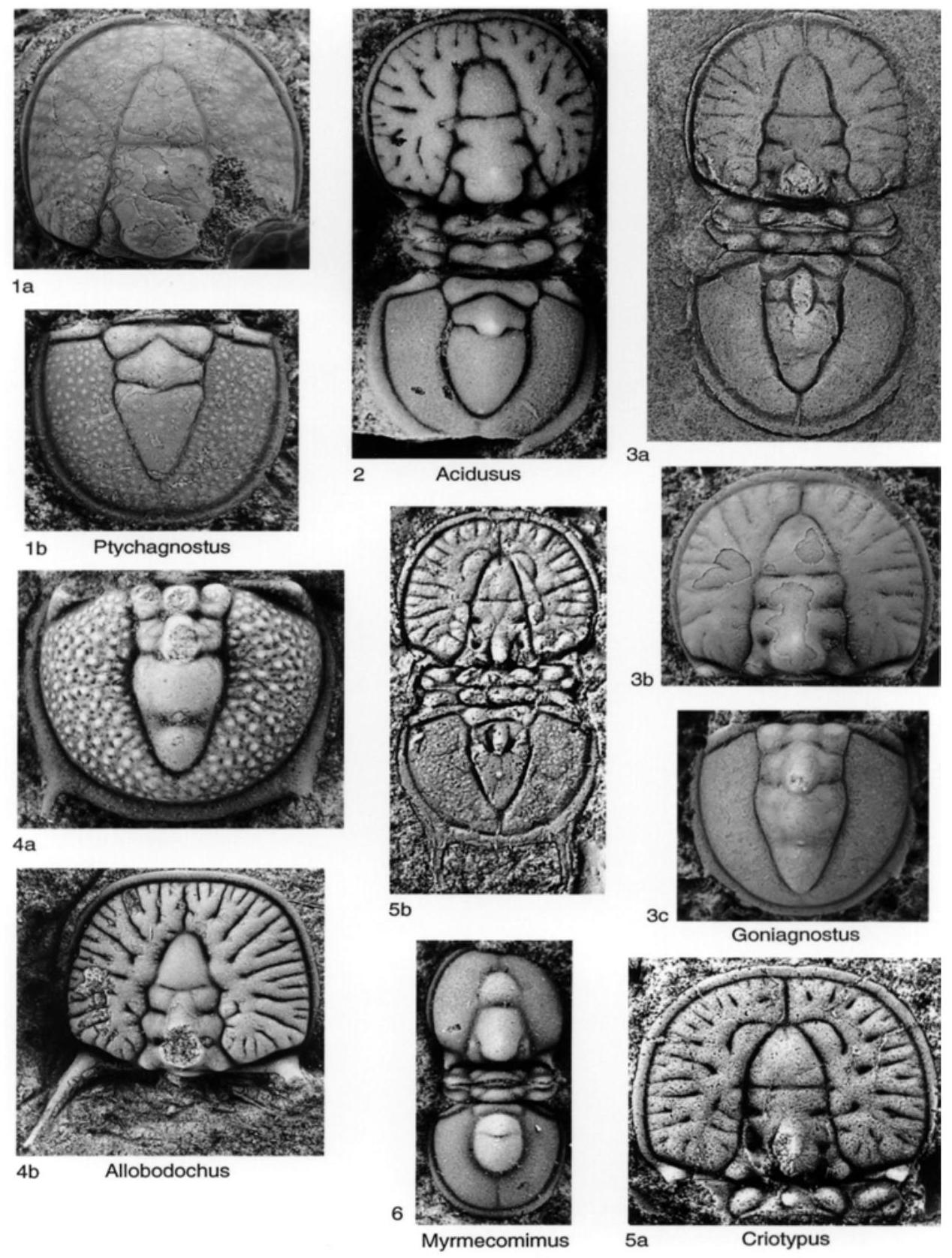Welcome to the Treatise on Invertebrate Paleontology!
Please enter a genera name to retrieve more information.

Rhaptagnostus
Classification
Phylum:
Arthropoda
Class:
Trilobita
Order:
Agnostida
Superfamily:
Agnostoidea
Family:
Diplagnostidae
Formal Genus Name and Reference:
Rhaptagnostus WHITEHOUSE, 1936, p. 97
Type Species:
*Agnostus cyclopygeformis Y. SUN, 1924, p. 26; OD; lectotype (Y. SUN, 1924, pl. 2, fig. 1e), 507, NIGP, Nanjing
Images
(Click to enlarge in a new window)
Fig. 233,3a. *R. cyclopygeformis (S UN ), Upper Cambrian (Changshanian, Kaolishania Zone), China (Kaolishan, Taian, Shandong); lectotype, pygidium, NIGP 507, × 7 (X. Sun, 1989, pl. 5, fig. 10).——Fig. 233,3b,c. R. convergens (P ALMER ), Upper Cambrian (Trempealeauan, Saukiella pyrene Subzone), USA (Eureka district, Nevada); b, paratype, cephalon, USNM 123563, ×10; c, holotype, pygidium, USNM 123562, ×9.5 (Shergold, 1977).
Synonyms
Geographic Distribution
Australia (Queensland), W. iota or R. apsis to N. quasibilobus or S. nomas Zones; China (Anhui, Hebei, Liaoning, Shandong, Yunnan, Qinghai, Xinjiang), Kaolishania to Tsinania Zones, (Zhejiang), L. punctatus Zone, (Guizhou), zone uncertain; North and South Korea, Fengshanian, Tsinania to Eoorthis Zones; Kazakhstan, E. scrobicularis to T. trisulcus Zones, Russia (Yakutia), P. perlata Zone; Canada (Northwest Territories, Newfoundland), Yukonaspis Zone; USA (Alaska, Montana, Nevada, Vermont), S. pyrene to S. serotina Subzones; Mexico, pre-Cordylodus proavus Zone.
Age Range
Beginning Stage in Treatise Usage:
Upper Cambrian
Beginning International Stage:
Guzhangian
Fraction Up In Beginning Stage:
50
Beginning Date:
498.75
Ending Stage in Treatise Usage:
Upper Cambrian
Ending International Stage:
Cambrian Stage 10
Fraction Up In Ending Stage:
100
Ending Date:
486.85
Description
Characteristically with subovoid to subcircular cephalon and pygidium; effaced to partly effaced; with nondeliquiate border furrows. Cephalon papilionate, with effaced median preglabellar furrow. Pygidium variably deuterolobate, with weakly constricted acrolobe; marginal spines well in advance of rear of deuterolobe.
References
Museum or Author Information
Classification
Phylum:
Arthropoda
Class:
Trilobita
Order:
Agnostida
Superfamily:
Agnostoidea
Family:
Diplagnostidae
Formal Genus Name and Reference:
Rhaptagnostus WHITEHOUSE, 1936, p. 97
Type Species:
*Agnostus cyclopygeformis Y. SUN, 1924, p. 26; OD; lectotype (Y. SUN, 1924, pl. 2, fig. 1e), 507, NIGP, Nanjing
Images
(Click to enlarge in a new window)
Fig. 233,3a. *R. cyclopygeformis (S UN ), Upper Cambrian (Changshanian, Kaolishania Zone), China (Kaolishan, Taian, Shandong); lectotype, pygidium, NIGP 507, × 7 (X. Sun, 1989, pl. 5, fig. 10).——Fig. 233,3b,c. R. convergens (P ALMER ), Upper Cambrian (Trempealeauan, Saukiella pyrene Subzone), USA (Eureka district, Nevada); b, paratype, cephalon, USNM 123563, ×10; c, holotype, pygidium, USNM 123562, ×9.5 (Shergold, 1977).
Synonyms
Geographic Distribution
Australia (Queensland), W. iota or R. apsis to N. quasibilobus or S. nomas Zones; China (Anhui, Hebei, Liaoning, Shandong, Yunnan, Qinghai, Xinjiang), Kaolishania to Tsinania Zones, (Zhejiang), L. punctatus Zone, (Guizhou), zone uncertain; North and South Korea, Fengshanian, Tsinania to Eoorthis Zones; Kazakhstan, E. scrobicularis to T. trisulcus Zones, Russia (Yakutia), P. perlata Zone; Canada (Northwest Territories, Newfoundland), Yukonaspis Zone; USA (Alaska, Montana, Nevada, Vermont), S. pyrene to S. serotina Subzones; Mexico, pre-Cordylodus proavus Zone.
Age Range
Beginning Stage in Treatise Usage:
Upper Cambrian
Beginning International Stage:
Guzhangian
Fraction Up In Beginning Stage:
50
Beginning Date:
498.75
Ending Stage in Treatise Usage:
Upper Cambrian
Ending International Stage:
Cambrian Stage 10
Fraction Up In Ending Stage:
100
Ending Date:
486.85
Description
Characteristically with subovoid to subcircular cephalon and pygidium; effaced to partly effaced; with nondeliquiate border furrows. Cephalon papilionate, with effaced median preglabellar furrow. Pygidium variably deuterolobate, with weakly constricted acrolobe; marginal spines well in advance of rear of deuterolobe.
